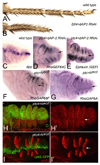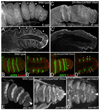Systematic expression and loss-of-function analysis defines spatially restricted requirements for Drosophila RhoGEFs and RhoGAPs in leg morphogenesis
- PMID: 20851182
- PMCID: PMC3029487
- DOI: 10.1016/j.mod.2010.09.001
Systematic expression and loss-of-function analysis defines spatially restricted requirements for Drosophila RhoGEFs and RhoGAPs in leg morphogenesis
Abstract
The Drosophila leg imaginal disc consists of a peripheral region that contributes to adult body wall, and a central region that forms the leg proper. While the patterning signals and transcription factors that determine the identity of adult structures have been identified, the mechanisms that determine the shape of these structures remain largely unknown. The family of Rho GTPases, which consists of seven members in flies, modulates cell adhesion, actomyosin contractility, protrusive membrane activity, and cell-matrix adhesion to generate mechanical forces that shape adult structures. The Rho GTPases are ubiquitously expressed and it remains unclear how they orchestrate morphogenetic events. The Rho guanine nucleotide exchange factors (RhoGEFs) and Rho GTPase activating proteins (RhoGAPs), which respectively activate and deactivate corresponding Rho GTPases, have been proposed to regulate the activity of Rho signaling cascades in specific spatiotemporal patterns to orchestrate morphogenetic events. Here we identify restricted expression of 12 of the 20 RhoGEFs and 10 of the 22 Rho RhoGAPs encoded in Drosophila during metamorphosis. Expression of a subset of each family of RhoGTPase regulators was restricted to motile cell populations including tendon, muscle, trachea, and peripodial stalk cells. A second subset was restricted either to all presumptive joints or only to presumptive tarsal joints. Depletion of individual RhoGEFs and RhoGAPs in the epithelium of the disc proper identified several joint-specific genes, which act downstream of segmental patterning signals to control epithelial morphogenesis. Our studies provide a framework with which to understand how Rho signaling cascades orchestrate complex morphogenetic events in multi-cellular organisms, and evidence that patterning signals regulate these cascades to control apical constriction and epithelial invagination at presumptive joints.
Copyright © 2010 Elsevier Ireland Ltd. All rights reserved.
Figures





Similar articles
-
Compartmentalisation of Rho regulators directs cell invagination during tissue morphogenesis.Development. 2006 Nov;133(21):4257-67. doi: 10.1242/dev.02588. Epub 2006 Oct 4. Development. 2006. PMID: 17021037
-
Fixing the GAP: The role of RhoGAPs in cancer.Eur J Cell Biol. 2022 Apr;101(2):151209. doi: 10.1016/j.ejcb.2022.151209. Epub 2022 Feb 10. Eur J Cell Biol. 2022. PMID: 35180567 Free PMC article. Review.
-
Systems analysis of RhoGEF and RhoGAP regulatory proteins reveals spatially organized RAC1 signalling from integrin adhesions.Nat Cell Biol. 2020 Apr;22(4):498-511. doi: 10.1038/s41556-020-0488-x. Epub 2020 Mar 23. Nat Cell Biol. 2020. PMID: 32203420
-
Prepatterning by RhoGEFs governs Rho GTPase spatiotemporal dynamics during wound repair.J Cell Biol. 2017 Dec 4;216(12):3959-3969. doi: 10.1083/jcb.201704145. Epub 2017 Sep 18. J Cell Biol. 2017. PMID: 28923977 Free PMC article.
-
Regulation of small GTPases at epithelial cell-cell junctions.Mol Membr Biol. 2011 Oct-Nov;28(7-8):427-44. doi: 10.3109/09687688.2011.603101. Epub 2011 Jul 25. Mol Membr Biol. 2011. PMID: 21781017 Review.
Cited by
-
Feedback inhibition of actin on Rho mediates content release from large secretory vesicles.J Cell Biol. 2018 May 7;217(5):1815-1826. doi: 10.1083/jcb.201711006. Epub 2018 Mar 1. J Cell Biol. 2018. PMID: 29496739 Free PMC article.
-
Tarsal-less peptides control Notch signalling through the Shavenbaby transcription factor.Dev Biol. 2011 Jul 15;355(2):183-93. doi: 10.1016/j.ydbio.2011.03.033. Epub 2011 Apr 17. Dev Biol. 2011. PMID: 21527259 Free PMC article.
-
The transcription factor Dysfusion promotes fold and joint morphogenesis through regulation of Rho1.PLoS Genet. 2018 Aug 6;14(8):e1007584. doi: 10.1371/journal.pgen.1007584. eCollection 2018 Aug. PLoS Genet. 2018. PMID: 30080872 Free PMC article.
-
Conundrum, an ARHGAP18 orthologue, regulates RhoA and proliferation through interactions with Moesin.Mol Biol Cell. 2013 May;24(9):1420-33. doi: 10.1091/mbc.E12-11-0800. Epub 2013 Mar 6. Mol Biol Cell. 2013. PMID: 23468526 Free PMC article.
-
A Multivariate Genome-Wide Association Study of Wing Shape in Drosophila melanogaster.Genetics. 2019 Apr;211(4):1429-1447. doi: 10.1534/genetics.118.301342. Epub 2019 Feb 21. Genetics. 2019. PMID: 30792267 Free PMC article.
References
-
- Bernards A. GAPs galore! A survey of putative Ras superfamily GTPase activating proteins in man and Drosophila. Biochim Biophys Acta. 2003;1603:47–82. - PubMed
-
- Bienz M, Saari G, Tremml G, Müller J, Züst B, Lawrence PA. Differential regulation of ultrabithorax in two germ layers of drosophila. Cell. 1988;53:567–576. - PubMed
Publication types
MeSH terms
Substances
Grants and funding
LinkOut - more resources
Full Text Sources
Molecular Biology Databases

